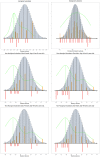Sense of personal control: Can it be assessed culturally unbiased across Aboriginal and non-Aboriginal Australians?
- PMID: 33002023
- PMCID: PMC7529283
- DOI: 10.1371/journal.pone.0239384
Sense of personal control: Can it be assessed culturally unbiased across Aboriginal and non-Aboriginal Australians?
Abstract
In recent decades, several studies have emphasized sense of personal control as a prominent aspect of Aboriginal health. However, one limitation is that instruments available to measure personal control were originally developed in western countries and validation for Aboriginal Australians has not been conducted. The aims of the current study were to evaluate whether the Sense of Personal Control Scale (SPCS) can be used to obtain culturally unbiased measurement of personal control across Aboriginal and non-Aboriginal Australians and to assess the psychometric properties of the SPCS for Aboriginal and non-Aboriginal Australian.
Methods: The current study utilized two Australian subsamples retrieved from the Teeth Talk Study (n = 317) and the National Survey of Adult Oral Health 2004-2006 (n = 3,857) in which the SPCS was included. Graphical Loglinear Rasch Models (GLLRM) were used to fulfill the aims of the study.
Results: The Perceived Constraints subscale fitted a GLLRM for Aboriginal Australians after the exclusion of three items, while fit to any Rasch model (RM) or GLLRM model could not be found in the non-Aboriginal sample. The Mastery subscale fitted a GLLRM in the non-Aboriginal sample after the exclusion of one item. In the Aboriginal sample, two items of the Mastery subscale fitted the RM, however, two items cannot be considered as a scale.
Conclusion: In the present study, we showed that the development of new items is crucial before the revised SPCS might constitute a valid and reliable measure of sense of personal control in both Aboriginal and non-Aboriginal Australian populations, and it is possible to assess whether the SPCS can be measured without bias across these two populations.
Conflict of interest statement
The authors have declared that no competing interests exist.
Figures


Similar articles
-
Psychometric properties of the Social Support Scale (SSS) in two Aboriginal samples.PLoS One. 2023 Jan 3;18(1):e0279954. doi: 10.1371/journal.pone.0279954. eCollection 2023. PLoS One. 2023. PMID: 36595553 Free PMC article. Clinical Trial.
-
Measuring stress in Australia: validation of the perceived stress scale (PSS-14) in a national sample.Health Qual Life Outcomes. 2020 Apr 15;18(1):100. doi: 10.1186/s12955-020-01343-x. Health Qual Life Outcomes. 2020. PMID: 32295596 Free PMC article.
-
Development and validation of an HPV infection knowledge assessment scale among Aboriginal and Torres Strait Islander Peoples.Vaccine X. 2023 May 24;14:100317. doi: 10.1016/j.jvacx.2023.100317. eCollection 2023 Aug. Vaccine X. 2023. PMID: 37288370 Free PMC article.
-
Improving the efficacy of healthcare services for Aboriginal Australians.Aust Health Rev. 2019 Jul;43(3):314-322. doi: 10.1071/AH17142. Aust Health Rev. 2019. PMID: 29335090
-
Development of an Aboriginal Resilience and Recovery Questionnaire - a collaboration between practitioners and help-seeking clients of a Victorian Aboriginal community controlled health service.BMC Med Res Methodol. 2023 Dec 8;23(1):290. doi: 10.1186/s12874-023-02091-4. BMC Med Res Methodol. 2023. PMID: 38066427 Free PMC article. Review.
Cited by
-
Assessment of Pain-Related Fear in Indigenous Australian Populations Using the Fear of Pain Questionnaire-9 (FPQ-9).Int J Environ Res Public Health. 2022 May 20;19(10):6256. doi: 10.3390/ijerph19106256. Int J Environ Res Public Health. 2022. PMID: 35627793 Free PMC article.
-
Culturally adapted developmental outcome measure for Aboriginal and Torres Strait Islander children: study protocol for the validation of the ASQ-STEPS.BMJ Open. 2025 Mar 12;15(3):e093029. doi: 10.1136/bmjopen-2024-093029. BMJ Open. 2025. PMID: 40074280 Free PMC article.
-
Cohort profile: South Australian Aboriginal Birth Cohort (SAABC)-a prospective longitudinal birth cohort.BMJ Open. 2021 Feb 22;11(2):e043559. doi: 10.1136/bmjopen-2020-043559. BMJ Open. 2021. PMID: 33619192 Free PMC article.
-
Exploratory Graph Analysis of the Strengths and Difficulties Questionnaire for Aboriginal and/or Torres Strait Islander Children.Front Psychol. 2021 Aug 18;12:573825. doi: 10.3389/fpsyg.2021.573825. eCollection 2021. Front Psychol. 2021. PMID: 34484017 Free PMC article.
-
The Weaving Healthy Families program: Promoting parenting practices, family resilience, and communal mastery.Fam Process. 2024 Mar;63(1):97-112. doi: 10.1111/famp.12854. Epub 2023 Jan 29. Fam Process. 2024. PMID: 36710265 Free PMC article.
References
-
- Carson B, Dunbar T, Chenhall RD, Bailie R. Social determinants of Indigenous health. Crows Nest, NSW: Allen & Unwin; 2007.
-
- Rotter JB. Generalized expectancies for internal versus external control of reinforcement. Psychological monographs: General and applied. 1966;80(1):1. - PubMed
-
- Pearlin LI, Menaghan EG, Lieberman MA, Mullan JT. The stress process. J Health Soc Behav. 1981:337–56. - PubMed
Publication types
MeSH terms
LinkOut - more resources
Full Text Sources

